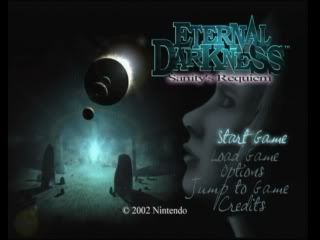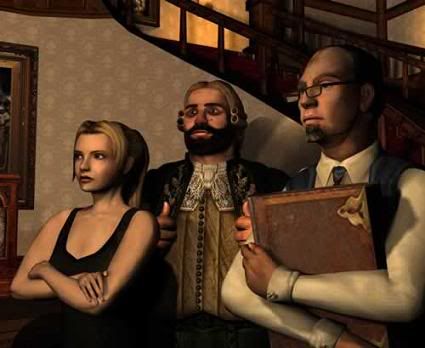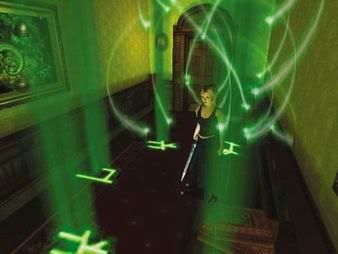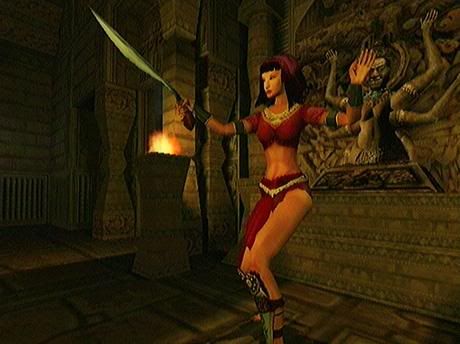This week’s Escapist, “Bump In The Night,” is all about survival horror. Here is the article I pitched them for the issue, all about one of the best games of the genre I never played until I got married.
I think there are certain elements of true horror in games that, like in the film industry, have been left aside for torture porn and jump-out scares. Few games that carry the horror moniker truly get inside the head of the player and compel them to struggle to survive, let alone prevail, and instead toss handfuls of gore and jarring images at the screen. A game that understood the meaning of horror and holds up despite the passing of one console generation to another is a humble title for the GameCube – Eternal Darkness: Sanity’s Requiem.

Instead of cribbing notes from more modern sources of horror such as Eli Roth or James Wan, Eternal Darkness reaches back to some of the more foundational writings of the genre, particularly H.P. Lovecraft and Edgar Allen Poe. The game, in fact, quotes Poe in the beginning, as we are introduced to Alexandra Roivas, a young woman whose grandfather Edward was murdered in his Rhode Island home. As the investigators have few answers, Alex begins looking around the mansion herself, and stumbles across a secret room containing, among other things, the “Tome of Eternal Darkness.” Upon opening this ghastly book, Alex is transported into the life of centurion Pious Augustus, who in 26 B.C. discovers one of three artifacts representing the essence of a powerful and old god-like being called an Ancient. As the player, you choose which Ancient corrupts Pious, setting up a conflict between the creature using the now-undying centurion as a proxy, and several characters throughout time including Alex who must stop the Ancient from ushering in a terrible age of eternal darkness.

Several generations of the Roivas family
Eternal Darkness has a minimal UI, keeping the screen from being too cluttered as you explore the game’s four locations at various points throughout history. Your life, “magick” and sanity meters only appeared when they were being affected. The player quickly begins to associate the different colors of the meters – red, blue and green, respectively – with the three Ancients and their minions, and must quickly learn how each affects the other. Ulyaoth, whose purview is over the soul, powers his minions through magick but is vulnerable to physical confrontation. Chattur’gha rules the body, making his pawns potent in a direct scrape but susceptible to mental assault. Xel’lotath reigns supreme in the realm of the mind and pushes the boundaries of one’s perceptions of reality through her servants, but must succumb to magickal assaults. Each has a color, a distinct personality and a unique appearance, but all three of them hate the neutral yet powerful fourth Ancient, Mantorok, whom the player’s characters come to represent whether they want to or not.
The spell-casting system of “magick” is one of the unique features of the game. Instead of giving the players direct instructions on how to use the runes discovered in various places and times, the player must experiment with the runes in what amounts to sentence construction. Basic spells involve three runes: the name of an Ancient which sets the spell’s “alignment”, a “verb” that describes what the player wants to do – summon, absorb, etc – and a “noun” that instructs the spell as to its target. Enhancement or “power” runes can expand a spell to five or seven runes, but the important part of the spell is its alignment. Trying to attack a minion of Xel’lotath with a physical spell isn’t going to work as well as the opposite. However, a spell aligned with Ulyaoth will do the trick nicely. Remembering this sort of thing on the fly as undead minions lumber towards you can make for a harrowing experience in and of itself. There’s also an option to discover the right rune to represent Mantorok.

On a story level, the common threads woven between the disparate lives of the dozen or so characters in Eternal Darkness drew them and the player into the dire and seemingly hopeless web of machinations of the Ancients. Well-written stories for each character coupled with excellent voice acting showed us mortal beings who found themselves struggling to maintain their sanity in the face of horrors from beyond the stars. And the insanity was not limited to the game’s side of the screen, because every so often, the game would quite directly remind the player that they are not entirely in control of what is happening to them with the use of the game’s infamous Insanity Effects. This innovation was so singular that Nintendo patented it.
Gamers often maintain a distance between themselves and the content of the game with the knowledge that they, ultimately, are in control of the events unfolding on the screen. Eternal Darkness broke through that barrier directly into the fear center of players’ brains. In addition to horrifying visions the characters see, witnessing a character’s head explode upon attempting to cast a healing spell or finding them walking across the ceiling when previously they were on the floor, the game occasionally poked holes through the fourth wall, by turning down the volume complete with a generic TV volume meter (a move guaranteed to blast out your eardrums if you were unprepared and tried turning up your TV in response), turning off the screen entirely or giving a false GameCube error screen. It’s not entirely uncommon for the player to echo the character’s panicked cry of “THIS ISN’T HAPPENING!”

Ellia, one of the game’s dozen characters.
Since Eternal Darkness, there have been few games that really got into the head of a player. Silent Hill 2 is often touted for the same sort of atmosphere and storytelling as Eternal Darkness, but when it comes to this sort of immersive survival horror gameplay, the list is pretty short. Survival is, after all, more than just fighting off wave after wave of zombies. Who are we when we emerge on the other side of such an experience? How do those events change us? Good survival horror should address those questions as well as “how many zombies can you kill in three minutes?” or “how many different ways can you kill zombies?” Killing zombies will always be fun in games, but few games balance that fun with sheer terror, let alone madness.
Horror is about more than just gore. Games, as a storytelling medium, should ideally be about more than complicated physics engines and shameless sex appeal. Horror games, then, should aspire to rise above the slavering hordes of the undead chasing down a trashy blonde with big tits. Alex Roivas may be an attractive blonde, but she’s also smart, not a marathon runner, and pretty reasonable and stable, at least when she first arrives at Edward’s mansion. Like James Sunderland of Silent Hill 2, she is pretty much alone in a haunted place slowly losing her grip on her sanity as she delves deeper and deeper into the mad secrets of the Tome of Eternal Darkness. We’re taken right along with her on this downward spiral, rather than observing from a distance. We want to maintain her stability because it’s the stability of our experience as well, and we want her to survive because we want to see how it ends. If that isn’t immersive storytelling, I don’t know what is.
Eternal Darkness doesn’t just set us up against slavering hordes of the undead with a selection of blunt, sharp and loud objects to fend them off. It sets up a situation that pulls is in, drives us forward and leaves us wondering how we made it through to the other side. The game becomes more than a mere simulation and serves as a medium for the invocation of primal fear. So few games since have tapped into that sort of emotional and psychological response because marketing trends seem to indicate that this sort of experience, singular and powerful as it may be, isn’t what the majority of gamers are looking for. The wide-spread critical acclaim of Eternal Darkness and its die-hard fans can’t compare to the masses clamoring for the next Halo game, at least in terms of spending power. Shooting or bludgeoning zombies over and over in various arenas is simpler than setting up a situation where facing a single creature can be a pants-wetting experience, and while it might be unfair to call the fans of the former sort of game “simple”, the evidence seems to speak for itself. As much as I will admit to enjoying blasting legions of shambling corpses, there are times when my brain cries out for something more, some immersive storytelling, an experience that means something. Eternal Darkness fits that bill perfectly, and when my brain starts making those noises I’m likely to play it again. The uninitiated player would hopefully find it to be a unique and unforgettable experience … if they survive.



March 30, 2010 at 7:35 pm
Definitely one of my favorite games ever.